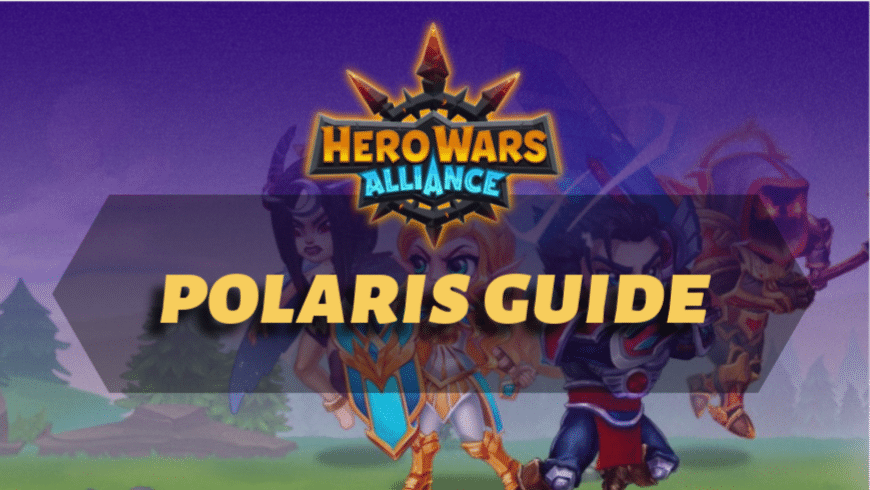
Introduction
Get ready to master Polaris with our ultimate Hero Wars Alliance Polaris Guide, and unlock her full potential to dominate every battle!
In the ever-evolving landscape of Hero Wars, new heroes are introduced regularly, each bringing their own unique dynamics and playstyles to the battlefield. Among these new additions, Polaris, the year-end hero of 2023, stands out as a particularly captivating and strategically deep character. Hailing from the far reaches of the cosmos, Polaris’s origins are tied to the stars, and she seeks refuge in the world of Dominion, where her extraordinary abilities can be fully realized. As a control Mage, Polaris is not focused on raw damage output but instead excels in enhancing her team’s capabilities by manipulating the flow of combat, making her an invaluable ally to those who favor a strategic, well-balanced approach.
At her core, Polaris is a support hero whose primary strength lies in her ability to disrupt the enemy team while providing powerful buffs and strategic advantages for her allies. She is far from a typical damage dealer. Think of her as a linchpin that enhances the control capabilities of her allies while simultaneously amplifying the magical power of her team. Her abilities, while not centered on dealing vast amounts of damage directly, allow her to create opportunities for other heroes to shine. In many ways, Polaris functions as a versatile utility hero who provides her team with vital control and support mechanisms, allowing for more aggressive plays from the rest of the team.
Lore-wise, Polaris’s story adds depth to her already intriguing character. As someone who hails from the stars, she carries with her the weight of a powerful, cosmic legacy. However, her journey in Dominion is not merely one of escape or exile; rather, it is a tale of adaptation and sacrifice. Polaris had to seal her celestial powers within a mortal form to interact with the world of Dominion, offering an additional layer of complexity to her presence on the battlefield. This backstory not only enriches her lore but also influences her role in battle, as her celestial abilities are now channeled through her mortal form, requiring her to strike a delicate balance between power and restraint.
Understanding Polaris’s core identity is key to unlocking her full potential in combat. While she may not be the hero to dish out massive bursts of damage, her control abilities—when properly utilized—can tilt the battle in her team’s favor. By enhancing the damage of her teammates, providing energy acceleration, and significantly extending the duration of control effects, Polaris ensures that the battlefield remains under her team’s influence. For those looking to harness her full power, embracing her role as a controller and supporter is crucial.
Skills
Polaris boasts a kit of four distinct skills, each contributing to her control and support-oriented playstyle. Her primary skill, Pulsing Comet, isn’t about shattering damage numbers, but rather about setting the stage for her control. This ability launches a comet that strikes the most distant enemy before traveling towards the front, exploding twice along its path and finally near its destination. Notably, it damages the entire enemy team, with a particular emphasis on the Frontline Heroes.
For strategic players, the skill can be manually interrupted, allowing you to concentrate the remaining damage in a specific area. Furthermore, each use of Pulsing Comet triggers the effect of her magic penetration artifact, benefiting not only Polaris but also other mages on your team. The base damage per pulse is around 31,832, scaling with her magic attack.
Polaris’s green skill, Glacial Fortress, introduces a fascinating layer of protection and energy acceleration. This ability conjures an ice barrier capable of withstanding three hits. Each time an enemy strikes this barrier, Polaris gains a valuable 10% energy bonus, potentially reaching a significant 30% energy boost after three hits.
This rapid energy gain allows her to access her more impactful skills more frequently. Additionally, the attacker is slowed down for 3 seconds, offering a minor form of disruption. Once the barrier absorbs three hits or its duration expires, it erupts into ice shards, dealing damage (approximately 11,486 based on her health) to nearby foes. The dual nature of Glacial Fortress – providing protection and accelerating energy – makes it a cornerstone of Polaris’s utility.
The blue skill, Northern Lights, is arguably the ability that truly defines Polaris’s supportive prowess. This skill unleashes an ethereal display of colors, forming a field effect above the enemy team. Its primary function is to extend the duration of her allies’ control effects by a substantial 60% when applied to affected enemies. Imagine the implications for heroes like Arachne, whose stun durations can be drastically prolonged.
Beyond enhancing your team’s control, Northern Lights also carries a disruptive element: it decreases the level of enemy skills that have a chance of activating by 10. This can be particularly effective against heroes with level-dependent skills, such as Sebastian’s ultimate, potentially weakening their impact. Because Northern Lights is a field effect, it’s generally more resilient to being blocked compared to status effects.
Finally, Polaris’s violet skill, True Freeze, acts as a potent follow-up to her other damaging abilities. Activated when either Pulsing Comet or Glacial Fortress explodes, True Freeze inflicts a freezing status on affected enemies for 3 seconds. During this time, enemies are stunned and, critically, lose their ability to accumulate energy or other resources.
Furthermore, enemies under the True Freeze effect become significantly more vulnerable to magic damage, taking 140% more, while their resistance to physical damage increases by 80%. This makes Polaris an excellent enabler for magic-heavy compositions. While True Freeze is a status effect and can theoretically be blocked by heroes like Sebastian, the presence of Northern Lights can sometimes help your control effects, including True Freeze, to land more reliably.
Strategic Roles and Team Compositions
Polaris’s unique skillset allows her to excel in two primary strategic roles: control support and damage support. In a control support configuration, the goal is to maximize the disruption and disablement of the enemy team. To achieve this, pair Polaris with another hero who possesses strong control abilities, such as Arachne or Lian.
In this setup, it’s often advantageous to direct Mara’s pet patronage towards the other control hero, further amplifying their effectiveness. Polaris’s role here is to use her Northern Lights to significantly extend the duration of their control effects, turning short stuns or silences into prolonged periods of vulnerability. The synergy with Arachne, as highlighted in the sources, demonstrates this perfectly, transforming her hyper-jump stun into an exceptionally long-lasting crowd control effect.
Alternatively, you can utilize Polaris as a damage support hero, focusing on bolstering the magic damage output of your team. In this scenario, it’s often beneficial to assign Mara’s pet patronage to Polaris herself. This extends the base duration of her True Freeze from 3 seconds to a more impactful 9 seconds, providing a prolonged window of opportunity for your magic damage dealers to capitalize on the 140% magic damage boost. Heroes who deal instant magic damage, such as Amira, synergize particularly well with Polaris in this role, as they can immediately exploit the increased vulnerability of frozen enemies. The practical demonstration with Aion, where his rocket damage dramatically increased under True Freeze, showcases the potential of this strategy.
Beyond these primary roles, Polaris’s ability to hinder enemy energy gain through her True Freeze can be strategically valuable against dodge-oriented heroes, potentially disrupting their ability to use their active skills frequently. While her primary strength lies in offensive formations, her control and damage-boosting capabilities may also find niche uses in defensive setups, although this is generally considered less of her forte.
Development Strategies
To unlock Polaris’s full potential, a strategic approach to her development is essential. When leveling Polaris’s skills, prioritize her blue skill (Northern Lights) and violet skill (True Freeze) first. The power of these skills lies in their core mechanics, which are initially independent of her health or magic attack stats, requiring primarily gold investments to level up. Focusing on these will immediately enhance her control and damage-boosting capabilities. After these, ensure you level up her primary skill, Pulsing Comet, and then her green skill, Glacial Fortress.
The order in which you develop Polaris’s artifacts can significantly impact her effectiveness. The first artifact to focus on should be the Guiding Star (Weapon Artifact), as it provides a crucial boost to magic penetration. This not only enhances Polaris’s damage but also amplifies the magical damage dealt by her allies, especially when Pulsing Comet is activated. The second artifact to prioritize is the Tome of Arcane Knowledge (Book Artifact), which increases her magic attack and health, contributing to both her damage output and survivability. Finally, the Ring of Intelligence (Ring Artifact) should be the third focus, further increasing her intelligence stat.
Before heavily investing in artifacts, ensure Polaris has a decent foundation of health and armor to improve her survivability on the battlefield. This will help her withstand incoming damage and stay in the fight longer to utilize her crucial support skills. It’s worth noting that Polaris’s magic defense seems to be somewhat reliant on her intelligence stat and might be comparatively lower than some other intelligence heroes.
Community consensus suggests that the default skin should be leveled up first. While other skins may offer different stat bonuses, the default skin provides a solid initial boost to her core attributes.
Counters
Understanding how Polaris interacts with common “counter” heroes is crucial for effective strategic team building in Hero Wars. While Polaris excels at supporting her allies and disrupting enemies with control and magical prowess, she is not without her vulnerabilities. Interestingly, she presents a unique challenge to some traditionally reliable mage counters, like Isaac and Sebastian, who typically shine against powerful mages. However, Polaris’s unique set of abilities and skill interactions allow her to defy expectations in these matchups.
Against Isaac, for example, Polaris doesn’t significantly contribute to his energy gain. Isaac’s primary mechanic revolves around stealing energy from his enemies, which powers his shield and ultimate abilities. However, Polaris’s Pulsing Comet primarily deals magic damage, which makes her less susceptible to Isaac’s energy-depleting effects that target physical attackers.
As a result, Isaac has a harder time stacking energy against her, limiting his ability to activate his ultimate and shield as frequently. In addition to this, Polaris’s passive blue and violet skills—specifically Northern Lights and True Freeze—can bypass the typical debuff strategies that Isaac relies on, further reducing his efficiency in countering her. Polaris’s ability to avoid triggering Isaac’s energy-stealing mechanics allows her to stay more active in combat, offering her team the opportunity to outlast Isaac’s defensive plays.
When facing Sebastian, Polaris’s ability to disrupt the enemy’s momentum becomes even more apparent. Sebastian is known for his Ultimate skill, which shields his allies and grants them buffs. Polaris can counter this in multiple ways. First, her Pulsing Comet and Glacial Fortress, when detonated, deal substantial damage, quickly breaking through Sebastian’s protective shield.
This prevents Sebastian from fully utilizing his ultimate, which depends on the strength of his shield to protect his team. Moreover, her Northern Lights skill has a subtle but powerful effect on the battlefield—it reduces the likelihood of enemy skills activating by 10%, which can further hinder Sebastian’s ability to effectively cast his ultimate and provide protection to his allies. By disrupting Sebastian’s defensive capabilities and reducing the effectiveness of his skills, Polaris becomes an unexpected yet potent counter to this typically powerful hero.
While Polaris has several advantages against key heroes like Isaac and Sebastian, she is by no means invincible. There are heroes who can exploit her weaknesses, and these counters are important to keep in mind when building a team around Polaris. Polaris is particularly vulnerable to heroes who can deal high burst damage. Heroes that excel at quickly eliminating key targets—such as Lars, Lilith, or Helios—can swiftly dispatch Polaris if she is not properly protected or supported by her team. Given that Polaris is a support hero with lower health and defenses, high burst damage champions can take advantage of this vulnerability and easily neutralize her in combat.
Furthermore, Polaris is at a significant disadvantage against heroes who specifically target the back line of the enemy team. Cleaver, Jhu, Kayla, Jorgen, and Luther are all heroes who can bypass Polaris’s defenses and reach her in the backline, where she is most vulnerable. Their abilities to pull, jump, or otherwise bypass the front lines make it harder for Polaris to position herself safely. These heroes often possess high mobility or direct targeting abilities that allow them to bypass front-line tanks, quickly getting to Polaris and overwhelming her with damage before she has the opportunity to activate her most potent abilities.
One of the most notable threats to Polaris is Corvus. As a hero known for his ability to deal substantial damage with his Altar of Death, Corvus can potentially outlast Polaris by dealing constant damage and absorbing some of the magical effects Polaris relies on. Given his resilience and his tendency to strike multiple times with strong bursts of damage, Corvus can pressure Polaris and prevent her from staying on the field long enough to make a significant impact on the match. His healing and ability to mitigate damage further complicate her chances of success in such confrontations.
Lastly, Satori, paradoxically, can also be a counter to Polaris. While Polaris’s abilities, especially her initial burst damage from Pulsing Comet and Glacial Fortress, are designed to quickly deal damage and disable enemies, Satori can benefit from this damage. Specifically, Satori gains energy when he is damaged, and the initial burst from Polaris can trigger Satori’s energy gain, allowing him to unleash his Ultimate and devastating attacks much sooner than anticipated. This interaction can be problematic for Polaris, as Satori’s ability to quickly gain energy can allow him to counter her disruptive abilities by casting his ultimate and potentially turning the tide in favor of the enemy team.
While Polaris undoubtedly brings a lot to the table with her control and support abilities, recognizing the heroes that can counter her is vital to creating effective team compositions. Her unique skill set allows her to stand up to some of the game’s most formidable counters, but when matched against high burst damage heroes or those capable of reaching the backline, she can be quickly overwhelmed. Understanding these matchups and preparing for them with careful team-building choices will help maximize Polaris’s potential and minimize the impact of her weaknesses.
Leading the Charge: Using Polaris in Alliance Wars and Game Modes
While specific strategies will depend on the game mode and your alliance’s overall approach, here are some general guidelines for utilizing Polaris effectively. In Alliance Wars, consider using Polaris in teams focused on disrupting key defensive setups. Her ability to counter Isaac and Sebastian can create unexpected advantages. Her control support capabilities can also be valuable in stalling and disabling powerful enemy heroes.
In offensive formations across various game modes, leverage her damage support by pairing her with your
strongest magic damage dealers to quickly eliminate threats. The extended True Freeze provides a significant window for burst damage. Experiment with different team compositions to discover the best synergies. Remember that Polaris excels at enhancing existing control and magic damage, so build teams around these strengths.
Conclusion
In conclusion, Polaris injects a refreshing and strategically deep element into Hero Wars: Dominion Era. Her versatility as both a control enhancer and a magic damage amplifier makes her a valuable asset to a wide range of team compositions. While she has her counters, her surprising resilience against traditionally strong mage counters like Isaac and Sebastian, coupled with her ability to significantly boost the control duration of her allies and amplify magic damage, positions her as a force to be reckoned with. By understanding her skills, strategic roles, development priorities, and interactions with other heroes, you can effectively harness the freezing radiance of Polaris and lead your alliance to victory.













